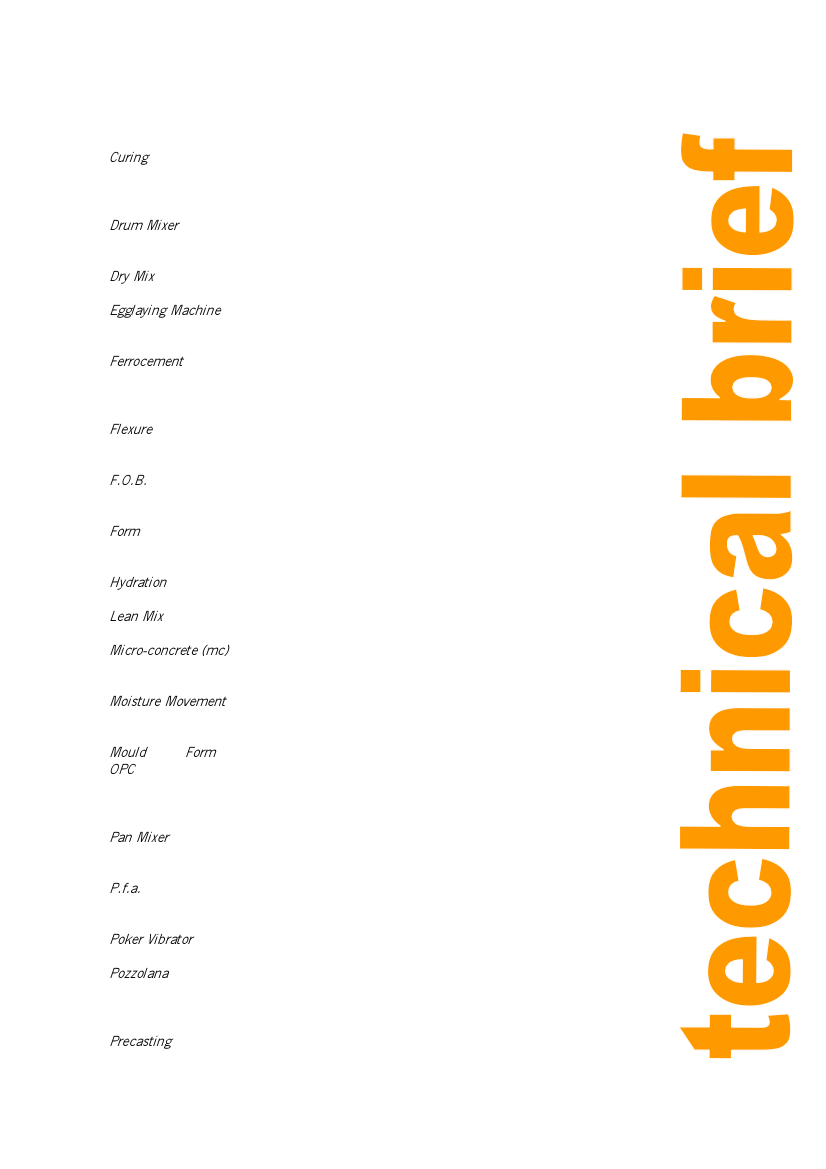
Introduction to concrete building products
Practical Action
section. Compressive strength forms the basis of quality control of concrete and the
design of concrete structures. If concrete is loaded in any other way (such as tension,
flexure, torsion or shear) it can carry much less load and reinforcement may be required.
• Curing - The gain in strength of concrete after the cement has set due to the continuing
chemical reaction between the cement and water. Under normal curing conditions,
concrete will have gained less than half its ultimate strength after a week and more than
90% of its ultimate strength after 90 days.
• Drum Mixer - A type of concrete mixer with an inclined drum and, usually no paddles.
Concrete is often removed from the mouth of the drum with shovels. Mixing is less
effective than with a pan mixer.
• Dry Mix - Concrete with only a small amount of water added. The concrete will barely feel
moist and will not flow at all. It needs to be rammed into moulds at high pressure.
• Egglaying Machine - A type of concrete blockmaking machine which will mould blocks
from freshly-mixed concrete and then eject them on the ground. The machine can then be
moved on a short distance to deposit another set of blocks.
• Ferrocement - A type of reinforced concrete usually incorporating a thin, relatively low cost
dense steel reinforcing mesh, such as chicken wire or fencing wire. The reinforcement
improves impact resistance, tensile and flexural strength, and enables thin sections of
concrete to be made.
• Flexure - Another word for bending. This typically occurs when a beam is loaded by an
imposed weight along its length. Concrete is weak in flexure and reinforcement often
needs to be provided when significant flexural loads are expected.
• F.O.B. - Free on Board, i.e. the purchase price includes the cost of packaging, insurance
and transport to a port in the suppliers' country. The purchaser is responsible for all
subsequent transport costs.
• Form - Solid material made to the shape of the intended concrete product or section.
Concrete is poured into the form and takes its shape. A form is used for cast-in-situ
concrete, whereas moulds are used for the same purpose in precasting.
• Hydration - The chemical reaction of Ordinary Portland cement and some other types of
cement with water. Concrete sets, hardens and gains strength due to hydration of cement.
• Lean Mix - Concrete which contains a relatively small amount of cement. It will be an
economical mix, but the compressive strength of the concrete will be relatively low.
• Micro-concrete (mc) – Concrete, usually quite a rich mix, made with just sand and cement
and without stones, gravel or coarse aggregate. This mix is usually used for roofing and
other types of tiles that have a thin profile.
• Moisture Movement - Concrete will expand and contract on wetting and drying. This
process is known as moisture movement. In long building sections, movement joints need
to be provided to allow for moisture movement and avoid cracking.
• Mould - See Form.
• OPC - Ordinary Portland Cement. A type of cement commonly used for concrete
throughout the world. International standards and often, also, national standards govern
its properties such as compressive strength, fineness, chemical composition, setting and
hardening times and other properties.
• Pan Mixer - A type of mixer containing a flat rotating pan and in which various paddles and
scrapers are inserted to facilitate mixing of concrete. After mixing the pan can be tilted up
for removal of concrete.
• P.f.a. - Pulverised fuel ash - a very fine ash obtained from the chimneys of coal burning
power stations. It usually has a high silica content and significant pozzolanic activity. It
may partially replace a proportion of cement in a mix.
• Poker Vibrator - A rod incorporating a vibrating unit. It is inserted into a concrete mix to
vibrate it and is usually used for large-scale sections.
• Pozzolana - A material, rich in silicon and aluminium oxide, which can react with lime to
produce a hydraulic cementitious material. When mixed with OPC it reacts with the by-
product lime produced during cement hydration and can, therefore, replace a proportion of
OPC.
• Precasting - The process of producing concrete products separate from actual construction
activities. After the products are sufficiently cured, they can be transported to the location
25